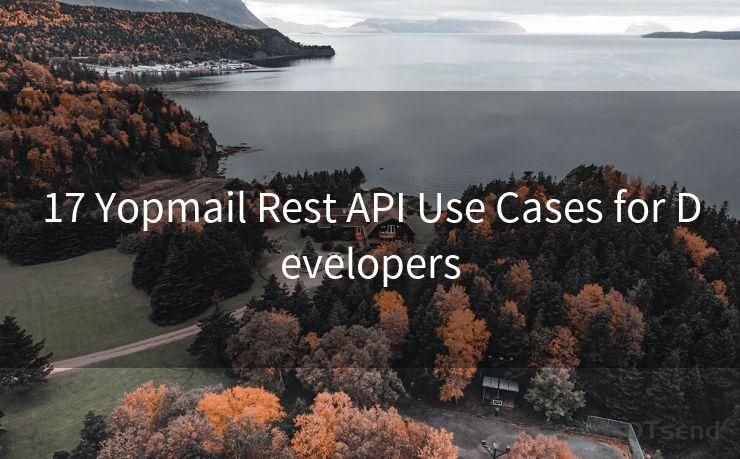Gmail API Overview: How to Send and Read Emails with Gmail API




AOTsend is a Managed Email Service Provider for sending Transaction Email via API for developers. 99% Delivery, 98% Inbox rate. $0.28 per 1000 emails. Start for free. Pay as you go. Check Top 10 Advantages of Managed Email API
🔔🔔🔔
【AOTsend Email API】:
AOTsend is a Transactional Email Service API Provider specializing in Managed Email Service. 99% Delivery, 98% Inbox Rate. $0.28 per 1000 Emails.
AOT means Always On Time for email delivery.
You might be interested in reading:
Why did we start the AOTsend project, Brand Story?
What is a Managed Email API, Any Special?
Best 25+ Email Marketing Platforms (Authority,Keywords&Traffic Comparison)
Best 24+ Email Marketing Service (Price, Pros&Cons Comparison)
Email APIs vs SMTP: How they Works, Any Difference?
Gmail API Overview: How to Send and Read Emails with Gmail API
The Gmail API offers a powerful way to manage emails programmatically, enabling users to send and read emails using their Gmail account. This guide will walk you through the essentials of using the Gmail API to send and read emails, highlighting key steps and tools such as Aotsend.
Introduction to the Gmail API
When exploring the Gmail API, it's crucial to understand its capabilities. The Gmail API provides developers with access to Gmail features, allowing them to integrate email functionalities into their applications. By using the Gmail API, you can automate tasks, manage email threads, and interact with the Gmail system programmatically. It’s a versatile tool for both simple and complex email operations.
Sending Emails with the Gmail API
Sending emails via the Gmail API is straightforward once you understand the basic steps. To send an email, you'll first need to set up the Gmail API in your project, authenticate your app, and obtain the necessary credentials. Then, you can use the users.messages.send method provided by the Gmail API. This method requires you to create a MIME message and encode it in base64 format.
Aotsend, a handy tool, can simplify this process. With Aotsend, you can seamlessly integrate the Gmail API into your workflow, making it easier to send emails programmatically. Whether you’re sending a single email or a bulk message, Aotsend enhances the efficiency of using the Gmail API for these tasks.

Reading Emails with the Gmail API
Reading emails with the Gmail API involves a similar setup process. You’ll need to authenticate and authorize your app to access the Gmail account. The Gmail API provides several methods for fetching email messages, including users.messages.list and users.messages.get. These methods allow you to retrieve and process email content according to your needs.
Again, Aotsend can be particularly useful here. By leveraging Aotsend’s features, you can streamline the process of reading and managing emails using the Gmail API. It helps you handle various email operations with ease, providing a user-friendly interface for interacting with the Gmail API.
Common Use Cases for the Gmail API
The Gmail API is versatile and supports a variety of use cases. For example, businesses often use the Gmail API to automate email marketing campaigns, manage customer support tickets, or synchronize email data across multiple systems. Individuals might use it for personal projects, such as creating automated reminders or organizing their inbox more effectively.
With tools like Aotsend, these use cases become more accessible. Aotsend’s integration with the Gmail API can enhance your ability to execute complex email operations, making it a valuable asset for both developers and end-users. It allows for a more intuitive interaction with the Gmail API, whether you're sending or reading emails.
Troubleshooting and Best Practices
Working with the Gmail API can sometimes present challenges, especially if you're new to the API. Common issues include authentication errors, API quota limits, and formatting problems with email messages. It's essential to follow best practices to mitigate these issues, such as handling API errors gracefully, optimizing your requests to stay within quota limits, and ensuring your email data is correctly formatted.
Aotsend can assist in troubleshooting these issues by providing comprehensive support and documentation. By using Aotsend alongside the Gmail API, you can reduce the likelihood of encountering common problems and enhance your overall experience with the API.
Conclusion
In summary, the Gmail API is a powerful tool for managing emails programmatically, offering a range of functionalities for sending and reading emails. By incorporating Aotsend into your workflow, you can streamline interactions with the Gmail API, making it easier to execute email operations efficiently. Whether you're automating email tasks or integrating email features into your application, the Gmail API and Aotsend together provide a robust solution for your email management needs.




AOTsend adopts the decoupled architecture on email service design. Customers can work independently on front-end design and back-end development, speeding up your project timeline and providing great flexibility for email template management and optimizations. Check Top 10 Advantages of Managed Email API. 99% Delivery, 98% Inbox rate. $0.28 per 1000 emails. Start for free. Pay as you go.
Scan the QR code to access on your mobile device.
Copyright notice: This article is published by AotSend. Reproduction requires attribution.
Article Link:https://www.aotsend.com/blog/p81.html





